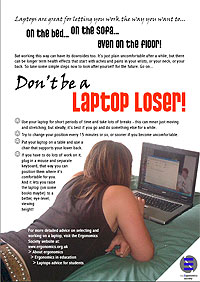The Ergonomics Society is appealing to parents to slip a safe usage pamphlet, by ergonomist Rachel Benedyk, into their son or daughter’s laptop case before they leave for university. The Society is also mailing out posters to universities to highlight the issue once the students are back on campus.
 But whilst this is aimed at university students the advice given in the small pamphlet can equally apply to anyone using laptops at work and in field situations such as telecom engineers.
But whilst this is aimed at university students the advice given in the small pamphlet can equally apply to anyone using laptops at work and in field situations such as telecom engineers.
Research, funded by the Stephen Pheasant Memorial Fund, and carried out by Rachel and her team at UCL (University College London) discovered that 57% of respondents to their survey had experienced aches & pains as a result of their laptop use, with 7% having pain a lot of the time. However, “an overwhelming majority were unaware of ergonomic guidance on using laptops”.
649 students from a range of nationalities completed the set of survey questions. 46% were male, 54% female, 41% undergraduates, 21% postgraduates. 38% research postgraduates. 166 teaching staff responded to a separate on-line survey. The most prevalent aches and pains were in the neck (21%), shoulders (21%), wrists (16%), back (15%) and eyes (11%).
The UK's Display Screen Equipment Regulations recommend limited use of laptops because their design imposes postural strain, heat emissions and high visual load, made worse by the fact that people often use them in the most inappropriate ways – on their laps or on the floor, for example. The UCL research bore this out with many respondents admitting to having frequently positioned their laptop on their laps (42%), in bed (29%) and on the floor (13%). See photo right: sitting on a sofa does not provide support for your back and is not recommended for places to use a laptop for any length of time.
Increasingly, students are bringing their own laptops to university. On average, such students are using their laptops for almost 5½ hours a day and Rachel’s view was that this length of time would be considered extensive in a risk assessment. There was also the issue of carrying the laptop around, with 67% of respondents concerned about its weight. However, fear of crime (49%) resulted in a more ergonomic outcome, for 21% of respondents carried their laptops in a backpack to conceal them – backpacks can distribute the weight more evenly than a bag carried on one shoulder, for example.
"University students use their laptops quite differently from school pupils; they want the portability and flexibility of a laptop, but they use them highly intensively in a complex and variable environment. We have shown that this raises ergonomic risks. We are currently seeking funding to extend and develop our research in this area,” said Rachel.
Her initial findings caused Rachel so much concern that she produced a short pamphlet giving ergonomics advice for students regarding laptop use.
Download poster in PDF form
Laptop Advice Leaflet
Source: The Ergonomics Society